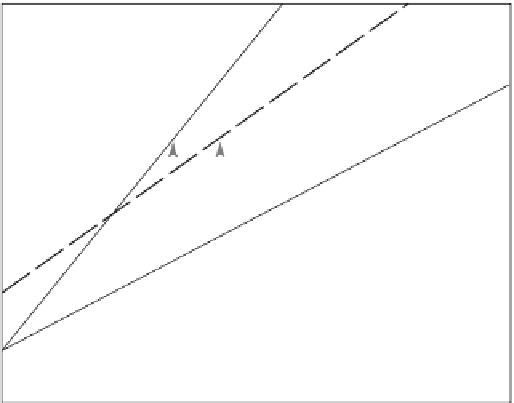Geoscience Reference
In-Depth Information
Today
Sample 3 (today)
T
1
T
0
solar
nebula
180
Hf/
183
W
Figure 12.13
The evolution of isochrons in the system
182
Hf-
182
W(
T
1
/
2
8.9 Ma). Contrary to standard
isochrons, the abscissa is the ratio of two stable isotopes. The solar nebula (open circle) is
supposed to be an infinite reservoir, so its composition belongs in any isochron, even though it
must be remembered that it changes through time. The isochrons represent three “samples”
(planetary objects) formed at
T
=
T
1
, and today. After a few half-lives, there is no
182
Hf
left and the
182
W/
183
W does not evolve any more.
=
T
0
,
T
=
in which we emphasize that the sample was born in isotopic equilibrium with the solar
equivalent to:
D
D
P
D
spl
today
=
D
D
SN
today
+
P
P
spl
=
SN
spl
today
−
P
D
SN
(12.12)
t
today
which is the equation of an isochron in a plot of (
D
/
D
)vs.(
P
/
D
). This equation shows
that the point SN belongs at all times to the isochron (it is simply a non-fractionated
sample of the solar nebula) and therefore that the isochrons revolve around this point
as it steepens vertically through time (
Fig. 12.13
). The situation is reminiscent of the
238
U-
230
Th isochron. For the
182
Hf-
182
W chronometer (
T
1
/
2
=
8.9 Ma), the last equation
reads:
182
W
183
W
180
Hf
183
W
spl
today
=
182
W
183
W
SN
today
+
182
Hf
180
Hf
spl
=
SN
spl
today
−
180
Hf
183
W
SN
t
today
(12.13)
This is the equation of the extinct radioactivity isochron (the conventional isochron cannot
be used when
P
0). When
182
W/
183
W is plotted against the
180
Hf/
183
W (note that
the two nuclides of the latter ratio are stable), samples formed at the same moment in
isotopic equilibrium with the solar nebula form a straight line with a slope indicative of
=














